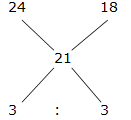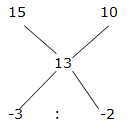Dear Readers, RRB Assistant is conducting Online Examination for the recruitment of Assistant. To enrich your preparation here we have providing new series of Inequality – Quantitative Aptitude Questions. Candidates those who are appearing in RRB Assistant Mains Exams can practice these Quantitative Aptitude average questions daily and make your preparation effective.
[WpProQuiz 3767]Click “Start Quiz” to attend these Questions and view Solutions
Click Here to view this Questions in Hindi
Directions (Q. 1 – 10): Each question below contains a statement followed by Quantity I and Quantity II. Find both to find the relationship between them. Mark your answer accordingly.
1) Preethi bought two articles A and B at Rs. X and Rs. X + 100 respectively. She sold article A at 15 % profit and article B at 10 % loss, and earned Rs. 30 as profit on the whole deal.
Quantity I: Find the profit earned by Preethi on selling article A?
Quantity II: Find the loss incurred (in Rs.) by Preethi on selling Article B but the loss % is 15?
a) Quantity I ≤ Quantity II
b) Quantity I ≥ Quantity II
c) Quantity I > Quantity II
d) Quantity I < Quantity II
e) Quantity I = Quantity II or Relation cannot be established
2) Quantity I: The diagonal of the square is 8√2. The area of the square is?
Quantity II: The perimeter of the square is 28 cm. Then the area of the square is?
a) Quantity I ≤ Quantity II
b) Quantity I ≥ Quantity II
c) Quantity I > Quantity II
d) Quantity I < Quantity II
e) Quantity I = Quantity II or Relation cannot be established
3) A box contains 5 Red balls, 3 white balls, 4 orange balls and 6 black balls.
Quantity I: If two balls are drawn at random, then find the probability that both balls are either Red or Orange?
Quantity II: If four balls are drawn at random, then find the probability that all are of different colours?
a) Quantity I ≤ Quantity II
b) Quantity I ≥ Quantity II
c) Quantity I > Quantity II
d) Quantity I < Quantity II
e) Quantity I = Quantity II or Relation cannot be established
4) Quantity I: 200 m long train can crosses a pole in 5 sec. The speed of the train is?
Quantity II: 250 m long train can crosses a platform of length 200 m in 15 sec. The speed of the train is?
a) Quantity I ≤ Quantity II
b) Quantity I ≥ Quantity II
c) Quantity I > Quantity II
d) Quantity I < Quantity II
e) Quantity I = Quantity II or Relation cannot be established
5) There are 120 students in a class whose average age is 21 years. The average age of the boys in the class is 24 years while the average age of the girls is 18 years?
Quantity I: No of boys in the class is?
Quantity II: No of girls in the class is?
a) Quantity I > Quantity II
b) Quantity I ≥ Quantity II
c) Quantity II > Quantity I
d) Quantity II ≥ Quantity I
e) Quantity I = Quantity II or Relation cannot be established
6) A person invested a sum of Rs. 50000 in two schemes A and B in which it offers simple interest at the rate of 15 % and 10 % respectively. The total interest received from these schemes after 3 years is Rs. 19500.
Quantity I: Sum of money invested in scheme A is?
Quantity II: Sum of money invested in scheme B is?
a) Quantity I ≤ Quantity II
b) Quantity I ≥ Quantity II
c) Quantity I > Quantity II
d) Quantity I < Quantity II
e) Quantity I = Quantity II or Relation can’t be established.
7) 2x × 3y = 108 and 8x = 64
Quantity I: The value of x?
Quantity II: The value of y?
a) Quantity I ≤ Quantity II
b) Quantity I ≥ Quantity II
c) Quantity I > Quantity II
d) Quantity I < Quantity II
e) Quantity I = Quantity II or Relation cannot be established
8) Quantity I: If x2 – 9x – 52 = 0, then the value of x is?
Quantity II: If y2 – 7x – 44 = 0, then the value of y is?
a) Quantity I ≤ Quantity II
b) Quantity I ≥ Quantity II
c) Quantity I > Quantity II
d) Quantity I < Quantity II
e) Quantity I = Quantity II or Relation cannot be established
9) Quantity I: A and B started a business by Rs. 10000 and Rs. 15000 respectively. A invested only 6 months and they divided their shares after a year. The ratio of profit of A and B is 2: 5. How many months B invested the money?
Quantity II: P and Q invested in the ratio of 4: 3. P invested the money for 9 months. The ratio of profit of P and Q is 2: 1. How many months Q invested the money?
a) Quantity I ≤ Quantity II
b) Quantity I ≥ Quantity II
c) Quantity I > Quantity II
d) Quantity I < Quantity II
e) Quantity I = Quantity II or Relation cannot be established
10) Quantity I: The present age of Asha is 12 years more the present age of Rahul. After 5 years the ratio of ages of Rahul and Asha will be 3: 5, and then find the age of Rahul, after 2 years?
Quantity II: The present age of Naveen is twice the present age of Priya. The ratio between the present ages of Gowrish and Priya is 7: 4. If the age of Naveen after 6 years will be 30 years, then find the age of Priya after 3 years?
a) Quantity I ≤ Quantity II
b) Quantity I ≥ Quantity II
c) Quantity I > Quantity II
d) Quantity I < Quantity II
e) Quantity I = Quantity II or Relation cannot be established
Answers :
Direction (1-10) :
1). Answer: d)
Explanation:
Article A Article B
CP RS. X Rs. (x + 100)
SP Rs. X *(115/100) Rs. (x + 100)*(90/100)
Now, profit = SP – CP
30 = 115x/100 + (90/100)*(x + 100) – x – x – 100
30 = (115x + 90x + 9000 – 200x – 10000)/100
3000 = 5x – 1000
5x = 4000
X = 800
Quantity I:
Profit earned on Article A
= > 800*(15/100) = Rs. 120
Quantity II:
Loss = 900*(15/100) = Rs. 135
Quantity I < Quantity II
2). Answer: c)
Explanation:
Quantity I:
The diagonal of the square = 8√2
Area of the square = 1/2(d2) = 1/2 (8√2)2
= > (1/2)*64*2 = 64 sq cm
Quantity II:
The perimeter of the square = 4a = 28 cm
Side (a) = 28/4 = 7 cm
Area of the square = (72) = 49 sq cm
Quantity I > Quantity II
3). Answer: d)
Explanation:
Total number of balls = 5 + 3 + 4 + 6 = 18
Quantity I:
n(S) = 18C2
Probability that both the balls are either Red or Orange
n(E) = 5C2 or 4C2
P(E) = n(E)/n(S) = 16/153
Quantity II:
n(S) = 18C4
n(E) = Probability that all the balls are of different colours = 5C1 and 3C1 and 4C1 and 6C1
P(E) = n(E)/n(S) = 2/17
Quantity I < Quantity II
4). Answer: c)
Explanation:
Quantity I:
The speed of the train = 200/5 = 40 m/sec
Quantity II:
The speed of the train = (250 + 200)/15 = 450/15 = 30 m/sec
Quantity I > Quantity II
5). Answer: e)
Explanation:
Boys girls

= > 1 : 1
2’s = 120
1’s = 60
Quantity I: Boys = 60
Quantity II: Girls = 60
Quantity I = Quantity II
6). Answer: c)
Explanation:
Percentage of interest received from these schemes
19500 = (50000*3*r)/100
R = (19500*100)/(50000*3) = 13 %
By the rule of allegation,

= > 3 : 2
5’s = 50000
1’s = 10000
Quantity I: Sum of money invested in scheme A= Rs. 30000
Quantity II: Sum of money invested in scheme B = Rs. 20000
Quantity I > Quantity II
7). Answer: d)
Explanation:
8x = 64
8x = 82
X = 2
22 × 3y = 108
3y = 108/4 = 27
3y = 33
Y = 3
Quantity I < Quantity II
8). Answer: e)
Explanation:
Quantity I:
x2 – 9x – 52 = 0
(x – 13) (x + 4) = 0
X = 13, -4
Quantity II:
y2 – 7x – 44 = 0
(y – 11) (y + 4) = 0
Y = 11, -4
Relation cannot be established
9). Answer: c)
Explanation:
Quantity I:
According to the question,
(10000*6)/(15000*x) = (2/5)
60000/15000x = 2/5
60000*5 = 15000x*2
X = (60000*5)/(15000*2)
X = 10 months
Quantity II:
According to the question,
(4*9)/(3x) = (2/1)
36/3x = 2/1
12/x = 2
X = 12/2 = 6
X = 6 months
Quantity I > Quantity II
10). Answer: e)
Explanation:
Quantity I:
Present age of Asha = 12 + Present age of Rahul
After 5 years, the ratio of ages of Rahul and Asha = 3: 5 (3x, 5x)
5x – 3x = 12
2x = 12
X = 6
The age of Rahul, after 2 years = 3x – 5 + 2 = 15 years
Quantity II:
The ratio of present age of Naveen and Priya = 2: 1
The ratio of present age of Gowrish and Priya = 7: 4
The present age of Naveen, Priya and Gowrish = 8: 4: 7
The age of Naveen, after 6 years = 30 years
The present age of Naveen = 24 years
8’s = 24
1’s = 3
The age of Priya after 3 years = 4x + 3 = 15 years
Quantity I = Quantity II
Daily Practice Test Schedule | Good Luck
| Topic | Daily Publishing Time |
| Daily News Papers & Editorials | 8.00 AM |
| Current Affairs Quiz | 9.00 AM |
| Quantitative Aptitude “20-20” | 11.00 AM |
| Vocabulary (Based on The Hindu) | 12.00 PM |
| General Awareness “20-20” | 1.00 PM |
| English Language “20-20” | 2.00 PM |
| Reasoning Puzzles & Seating | 4.00 PM |
| Daily Current Affairs Updates | 5.00 PM |
| Data Interpretation / Application Sums (Topic Wise) | 6.00 PM |
| Reasoning Ability “20-20” | 7.00 PM |
| English Language (New Pattern Questions) | 8.00 PM |
Click Here for More Quantitative Aptitude Questions





